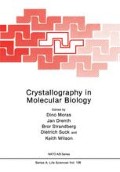Abstract
The major purpose of molecular graphics is that of modeling, that is the representation of structure and/or process for the purposes of evaluation and understanding. Developments in computation and computer graphics have enabled the production and use of powerful tools for molecular modeling, far surpassing the physical models originally used for the purpose. Hardware advances in processor and display technologies have made possible real-time manipulation of three-dimensional models of increasing complexity and “realism”. Algorithmic developments are producing a variety of useful. interpretable representations and intelligible renderings for construction and display of models. Because of these advances, it becomes most important to emphasize the distinction between model and primary observation. The computer generated image or simulation may look compelling. but seeing is not believing. Looking is the name of the game. A model is only as good as the information used to construct it.
Access this chapter
Tax calculation will be finalised at checkout
Purchases are for personal use only
Preview
Unable to display preview. Download preview PDF.
References
Richards, F. M., 1977, “Areas, volumes, packing, and protein structure”, Annu. Rev. Biophys. and Bioeng. 6:151–176.
Pearl, L. H., and Honegger. A., 1983, “Generation of molecular surfaces for graphic display”,J. Mol. Graphics 1:9–12.
Connolly, M. L., 1983, “Solvent-accessible surfaces of proteins and nucleic acids”,Science 221:709–713.
O’Donnell, T. J.. and Olson. A. J.. 1981, “CRAMPS -A graphics language interpreter for real-time, interactive, three-dimensional picture editing and animation”. Computer Graphics 15:133.
Connolly, M. L.: and Olson. A. J., 1985, “GRANNY. A companion to CRAMPS for the real-time manipulation of macromolecular modes”. Computers &Chem. 9:1–6.
Tainer. J. A., Cetzoff. E. D., Connolly, M. L., Olson, A. J., 1983, “Topography of protein surfaces”,Fed. Proc. 42:1998.
Getzoff. E. D., and Tainer, J. A.. 1985, “Superoxide dismutase as a model ion channel”,In Ion Channel Reconstitution (C. Miller, ed.), Plenum, New York.
Connolly. M. L., 1983, “Analytical molecular surface calculation”,J. Appl. Crystallogr. 16:548–558.
Connolly, M. L., 1985, “Depth-buffer algorithms for molecular modeling”,J. Mol. Graphics 3:19–24.
Pique, M.. 1982, “What does a protein look like”,computer animated film, University of North Carolina.
Kuntz. I. D., Blaney, J. M., Oatley, S. J., Langridge, R., and Ferrin, T. E., 1982, “A geometric approach to macromolecule-ligand interactions,” J. Mol. Biol. 161:269–288.
Taylor, W. R.. Thornton, J. M., and Turnell, W. G., 1983, “An ellipsoidal approximation of protein shape” , J. Mol. Graphics 1:30–39.
Tainer, J. A., Getzoff, E. D., Alexander. H., Houghten. R. A., Olson. A. J., Lerner, R. A., and Hendrickson, W. A., 1984, “The reactivity of anti-peptide antibodies is a function of the atomic mobility of sites in a protein” , Nature 312:127–133.
Tainer. J. A., Getzoff, E. D., Paterson, Y., Olson, A. J., and Lerner, R. A.. 1985. “The atomic mobility component of protein antigencity”, Annual Review Immunol. 3:501–535.
Getzoff, E. D.. Tainer, J. A., Weiner, P. K., Kollman, P. A., Richardson. J. S.. and Richardson, D. C., 1983, “Electrostatic recognition between superoxide and copper, zinc superoxide dismutase”, Nature 306:287–290.
Weiner. P. K.. and Kollman, P. A., 1981, “AMBER: Assisted model building with energy refinement. A general program for modeling molecules and their interactions”. J. of Computational Chem. 2:287–303.
Tainer, J. A., Getzoff, E. D., Richardson, J. S.. and Richardson. D. C., 1983. “Structure and mechanism of copper, zinc superoxide dismutase”, Nature 306:284–287.
Getzoff, E. D., Tainer, J. A. and Lerner. R. A., 1985, “The chemistry of antigen-antibody union”, In Immune Regulation, (M. Feldmann. ed.) Humana Press. Clifton, NJ, in press.
Freeman, H. C., Getzoff, E. D., and Tainer, J. A., 1984. “Electrostatic effects in metalloprotein electron transfer: A computer graphics study of the interaction between plastocyanin and cytochrome c” , Proceedings of the Division of Coordination and Metal-Organic Chemistry of the Royal Australian Chemical Institute ,in press.
Getzoff, E. D., Tainer, J. A., and Olson, A. J., 1985, “Recognition and interactions controlling the assemblies of ß barrel domains”, Biophys. J. 49 in press.
Olson, A. J., Getzoff, E. D. and Tainer, J. A., 1984, “Terms of entrapment: Structure and function of superoxide dismutase”, computer animated film, copyright Research Institute of Scripps Clinic.
Author information
Authors and Affiliations
Editor information
Editors and Affiliations
Rights and permissions
Copyright information
© 1987 Springer Science+Business Media New York
About this chapter
Cite this chapter
Olson, A.J., Tainer, J.A., Getzoff, E.D. (1987). Computer Graphics in the Study of Macromolecular Interactions. In: Moras, D., Drenth, J., Strandberg, B., Suck, D., Wilson, K. (eds) Crystallography in Molecular Biology. NATO ASI Series, vol 126. Springer, Boston, MA. https://doi.org/10.1007/978-1-4684-5272-3_11
Download citation
DOI: https://doi.org/10.1007/978-1-4684-5272-3_11
Publisher Name: Springer, Boston, MA
Print ISBN: 978-1-4684-5274-7
Online ISBN: 978-1-4684-5272-3
eBook Packages: Springer Book Archive

